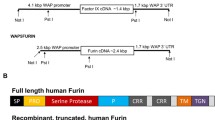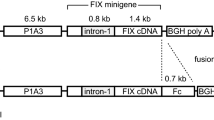Abstract
Objectives
To investigate the reasons for the instability of human coagulation factor FVIII (hFVIII) in milk which is an intractable obstacle during the hFVIII production by a transgenic mammary gland bioreactor.
Results
We constructed P1A3-hFVIIIBDD and P1A3-hFVIIIBDD-IRES-vWF co-expression cassettes for generating transgenic mice. P1A3-hFVIII/CMV-vWF double heterozygotes were also prepared by mating P1A3-hFVIIIBDD with CMV-vWF mice. hFVIII bioactivity in milk was determined under different storage conditions. The half-life (in vitro) of hFVIII bioactivity in P1A3-hFVIIIBDD-IRES-vWF mice was significantly longer than P1A3-hFVIIIBDD mice [77 ± 4.9 vs. 44 ± 2.6 h at 4 °C, 32.5 ± 5 vs. 19.7 ± 0.6 h at room temperature and 7.4 ± 1.4 vs. 3.4 ± 0.6 at 37 °C, respectively (P < 0.05)]. The half-life (in vitro) of hFVIII bioactivity in milk of double heterozygotes was similar to P1A3-hFVIIIBDD-IRES-vWF ones, demonstrating that the vWF transgene expression in hFVIII transgenic mice can efficiently improve the stabilization of hFVIII bioactivity in milk.
Conclusion
We provide a new approach of P1A3-hFVIIIBDD-IRES-vWF co-expression to generate more stable hFVIII in transgenic milk with rapid and low cost as well as valuable information for producing pharmaceutical proteins by transgenic mammary gland bioreactor.



Similar content being viewed by others

Abbreviations
- hFVIII:
-
Human coagulation factor VIII
- hFVIIIBDD:
-
hFVIII cDNA fragment with B domain deleted
- IRES:
-
Internal ribosome entry site
- P1A3:
-
Goat β-casein promoter region
- vWF:
-
von Willebrand factor
References
Chen CM, Wang CH, Wu SC, Lin CC, Lin SH, Cheng WT (2002) Temporal and spatial expression of biologically active human factor VIII in the milk of transgenic mice driven by mammary-specific bovine alpha-lactalbumin regulation sequences. Transgenic Res 11:257–268
Chrenek P, Ryban L, Vetr H, Makarevich AV, Uhrin P, Paleyanda RK, Binder BR (2007) Expression of recombinant human factor VIII in milk of several generations of transgenic rabbits. Transgenic Res 16:353–361
Farid SS (2007) Process economics of industrial monoclonal antibody manufacture. J Chromatogr B 848:8–18
Fay PJ, Coumans JV, Walker FJ (1991) von Willebrand factor mediates protection of factor VIII from activated protein C-catalyzed inactivation. J Biol Chem 266:2172–2177
Ismail B, Nielsen SS (2010) Invited review: plasmin protease in milk: current knowledge and relevance to dairy industry. J Dairy Sci 93:4999–5009
Jacquemin M (2009) Factor VIII-von Willebrand factor binding defects in autosomal recessive von Willebrand disease type Normandy and in mild hemophilia A. New insights into factor VIII-von Willebrand factor interactions. Acta Haematol 121:102–105
Lenting PJ, Pegon JN, Christophe OD, Denis CV (2010) Factor VIII and von Willebrand factor–too sweet for their own good. Haemophilia 16(Suppl 5):194–199
Niemann H, Halter R, Carnwath JW, Herrmann D, Lemme E, Paul D (1999) Expression of human blood clotting factor VIII in the mammary gland of transgenic sheep. Transgenic Res 8:237–247
Paleyanda RK, Velander WH, Lee TK, Scandella DH, Gwazdauskas FC, Knight JW, Hoyer LW, Drohan WN, Lubon H (1997) Transgenic pigs produce functional human factor VIII in milk. Nat Biotechnol 15:971–975
Pipe SW, Miao H, Butler SP, Calcaterra J, Velander WH (2011) Functional factor VIII made with von Willebrand factor at high levels in transgenic milk. J Thromb Haemost 9:2235–2242
Saenko EL, Scandella D (1997) The acidic region of the factor VIII light chain and the C2 domain together form the high affinity binding site for von willebrand factor. J Biol Chem 272:18007–18014
Schmidt C (2006) Belated approval of first recombinant protein from animal. Nat Biotechnol 24:877
Tang L, Leong L, Sim D, Ho E, Gu JM, Schneider D, Feldman RI, Monteclaro F, Jiang H, Murphy JE (2013) von Willebrand factor contributes to longer half-life of PEGylated factor VIII in vivo. Haemophilia 19:539–545
Wang Q, Gong XL, Gong ZJ, Ren XY, Ren ZR, Huang SZ, Zeng YT (2013) The mesenchymal stem cells derived from transgenic mice carrying human coagulation factor VIII can correct phenotype in hemophilia A mice. J Genet Genomics 40:617–628
Wei J, Yang X, Zheng M, Wang M, Dai Y, Chen Z, Li N (2011) The recombinant chimeric antibody chHAb18 against hepatocellular carcinoma can be produced in milk of transgenic mice. Transgenic Res 20:321–330
Acknowledgments
This work was supported by the Grants from the National High Technology Research and Development Program (“863’’Program) of China (No. 2011AA100602), National Science and Technology Major Project of the Ministry of Science and Technology of China (No. 2013ZX09102037) and the Experimental Animals Project from Shanghai Municipality (No. 12140900600).
Supporting information
Supplementary Table 1—The degradation rate of hFVIII concentration in transgenic mouse milk in vitro.
Supplementary Fig. 1—Schematic diagram of transgene fragments.
Supplementary Fig. 2—Screening of transgenic mice by PCR.
Supplementary Fig. 3—ELISA detection of hFVIII–vWF binding in transgenic milk.
Additional details: 1. Construction of transgenic cassettes. 2. PCR procedure
Author information
Authors and Affiliations
Corresponding author
Additional information
X. Ren and X. Gong contributed equally to this paper.
Electronic supplementary material
Below is the link to the electronic supplementary material.
10529_2015_1793_MOESM1_ESM.tif
Supplementary material 1 (TIFF 129 kb) Schematic diagram of transgene fragments A. Vector P1A3-hFVIIIBDD: this vector contains hFVIIIBDD cDNA about 4.5 kb (deleted 2640 basic group from 2335 to 4974 bp encoding 760aa–1639aa) launched by P1A3 promoter. P1A3 is the goat β-casein promoter sequence including 4.3 kb of upstream regulatory sequence, exon 1, intron 1 and exon 2. B. Vector CMV-vWF: vWF cDNA fragement about 9 kb is constructed driven by CMV. C. Vector P1A3-hFVIIIBDD-IRES-vWF: a co-expression vector in which hFVIIIBDD cDNA, IRES element and vWF cDNA are successively constructed in one vector. The fragments show that they are digested by restriction enzyme SalI, eventually used in preparation of transgenic mice
10529_2015_1793_MOESM2_ESM.tiff
Supplementary material 2 (TIFF 111 kb) Screening of transgenic mice by PCR The PCR detection for founder mice is as shown. M is 1 Kb marker. 1–4 DNA samples obtained from P1A3-hFVIIIBDD mice #54, P1A3-hFVIIIBDD-IRES-vWF co-expression mice #2, P1A3-hFVIIIBDD/CMV-vWF double heterozygous mice #54/22 and CMV-vWF mice #22 in order. WT stands for wild type mice as control
10529_2015_1793_MOESM3_ESM.tif
Supplementary material 3 (TIFF 39463 kb) ELISA detection of hFVIII–vWF binding in transgenic milk shows that the contents of vWF vary accordingly with the changes of hFVIII concentration. Polynomial trends are shown for P1A3-hFVIII-IRES-vWF co-expression mice (#2, gray line), P1A3-hFVIII/CMV-vWF double heterozygous mice (#54/22, black line) and P1A3-hFVIII transgenic mice (#54, dotted blank line)
Rights and permissions
About this article
Cite this article
Ren, X., Gong, X., Cai, Q. et al. Efficient stabilization of recombinant human coagulation factor VIII in the milk of transgenic mice using hFVIII and vWF co-expression vector transduction. Biotechnol Lett 37, 1187–1194 (2015). https://doi.org/10.1007/s10529-015-1793-5
Received:
Accepted:
Published:
Issue Date:
DOI: https://doi.org/10.1007/s10529-015-1793-5



